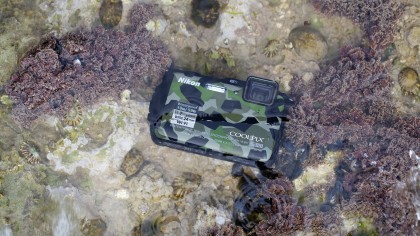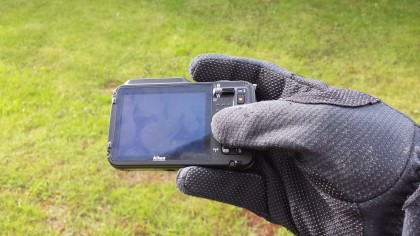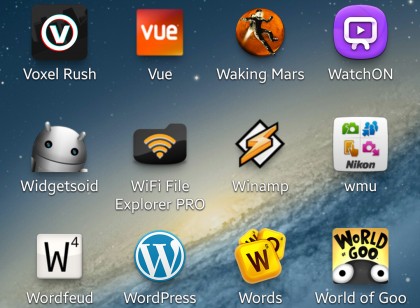TechRadar Verdict
A good compact camera with plenty of features, but only really worth the price if you need its waterproof, shockproof qualities.
Pros
- +
Rugged construction
- +
Wi-Fi and GPS
- +
Quick and responsive
- +
Decent image quality
Cons
- -
Small controls
- -
Limited zoom range
- -
High price
- -
No touchscreen
Why you can trust TechRadar
This, the third entry in the ruggedised Coolpix AW series since its launch in 2011, can be immersed in water down to 18 metres (the deepest you can go with an open water diving licence), survive drops from two metres and put up with temperatures down to -10ºC.
Aimed at hikers, swimmers and the generally adventurous, the AW120 carries all the features we've come to expect from modern compact cameras, with the ability to record movies at 1080p and at a variety of frame rates, including 8x slow motion with a drop in resolution to 240p. There's also a barometer, altimeter, depth gauge and compass, as well as a Wi-Fi connection to Nikon's remote control smartphone app and GPS to tag your photos' location, wherever you are in the world.
Those photos come courtesy of a 16-million-pixel, back illuminated, 1/2.3in CMOS sensor combined with a lens that zooms from 24-120mm in 35mm terms (that's 5x) and which benefits from Vibration Reduction. The zoom range can be further extended with Nikon's Dynamic Fine Zoom digital zoom technology, at the cost of image quality. At its widest setting the lens can open its aperture up to a reasonably fast f/2.8, allowing in more light for those spectacular sunset shots while you're hiking halfway up a mountain range (and which will also come in handy underwater).

This isn't a great deal of a spec bump over the AW110, which featured the same type of sensor and all the same wireless features. The AW120's screen (a three-inch, 921k-dot OLED model) has more dots and will therefore be sharper to look at than the 614k dots on the AW110. The newer model also manages two more stops of ISO sensitivity, maxing out at 6400 rather than the AW110's 1600, and opens its lens up almost a full stop wider than the old model's f/3.9 maximum aperture. The two cameras even look identical.
The market for waterproof compact cameras isn't a huge one, but the AW120 still finds itself with some competition. There's the Panasonic Lumix FT5, which is a little cheaper but can't go as deep underwater, while the Canon Powershot D30 can survive all the way down to 25 metres but loses out in terms of megapixels (it has 12) and lacks the AW120's Wi-Fi connectivity.
Build quality and handling
Being a rugged camera you'd expect the AW120 to be well built, and it certainly is. Ports through which water could flood in – battery, micro USB, micro HDMI and SD card – are bunched together on the right-hand side and covered by a sealed door that requires a press of a button and the turn of a wheel to open. This locking wheel is about the same size as a DSLR's mode selection dial, by far the largest control on the body, and doesn't snap shut - the wheel has to be turned every time you close the protective door, and the camera will nag you to check that it's closed tightly the next time you turn it on.

The design of the camera means the lens doesn't protrude from the casing as it does in most other compacts in this price bracket, which must be a challenge to build and explains the small zoom range. In fact, the AW120 is such a compact package that, as convenient as this may be for slipping in a pocket ready for spelunking, its controls are quite tricky to use accurately with gloves on. It's quite possible to press two buttons at once while wearing relatively thin gloves, let alone anything you'd want to use for skiing, a thumb easily covering the entire mode selector and the two buttons above it.
Sign up for breaking news, reviews, opinion, top tech deals, and more.

The buttons are responsive, the menus straightforward to navigate and you're rarely left waiting for the AW120 to finish an operation, even when it's processing one of its built-in image effects.
The screen on the camera's rear has an anti-reflection coating that copes adequately with direct sunlight but which excels in terms of viewing angle. The image on it remains visible no matter how much the camera is twisted, only vanishing when the turning of the camera body obscures it. The only thing it lacks is touch sensitivity.

Wireless features
The GPS is a simple menu option away, and its embedded data is immediately picked up in iPhoto's Places feature. Using the Wi-Fi proved slightly trickier, however, leading to a bit of head-scratching until it was realised that it wouldn't work without a well-charged battery and an SD card in the camera. Popping in an empty micro SD adapter wasn't enough to fool it, it has to be a genuine card.
Once it was working, however, the wireless connection to a Samsung Galaxy S4 proved perfectly stable. The live view feed was a little laggy, but perfectly adequate for taking pictures with the camera held under the surface of a stream, or poking out of a tent to check for bears.
Nikon's Wireless Mobile Utility is a sparse app, with no options other than zooming the lens, taking pictures and copying them across to your phone or tablet. This is a bit of a missed opportunity, as a full remote control app would be a great feature to have. Nikon should also consider renaming it - the simple 'wmu' label on the icon easily gets lost among a crowded app list.

The 330MB of internal memory can hold around 40 shots, while you can use SDXC cards to add massive storage - handy for video shooters but, as there's no raw image format support, still image JPEGs will fill those 128GB cards rather more slowly.
